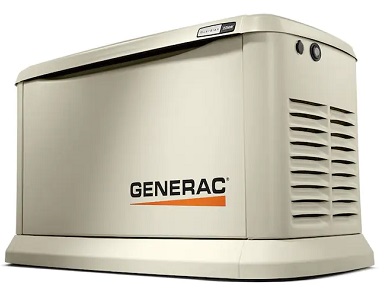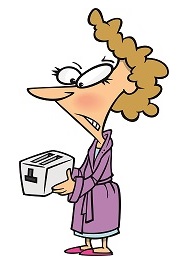![]()
How does a Backup Generator Work? [Backup Basics]
DISCLAIMER: AS AN AMAZON ASSOCIATE I EARN FROM QUALIFYING PURCHASES. THIS POST CONTAINS AFFILIATE LINKS THAT WILL REWARD ME MONETARILY OR OTHERWISE WHEN YOU USE THEM TO MAKE QUALIFYING PURCHASES. FOR MORE INFORMATION, PLEASE READ MY EARNINGS DISCLAIMER.
If you have a standby generator, it will usually kick in as soon power outage is detected. When you get the power back, the automatic transfer switch will turn off the generator and restore normal utility power service to your home. In case you are using a manual transfer switch instead of an automatic one, you will need to flip it manually and start your generator to get power.
Standby generators are usually hard-wired into the electrical system of your home or business and are using natural gas or propane as fuel. Some generators can use both. On industrial sights, you will commonly see giant diesel generators that been there for ages and still keep ongoing…
A portable generator, on the other hand, is meant to be portable and is rarely used as a full house backup. They are usually kept in a garage and taken out in the event of a blackout. There is no permanent hard-wiring and since they are not as powerful as full-size standby generators, they are generally used as a partial house backup solution.
Power generation is a process of transforming mechanical or chemical energy into electrical. In generators, it’s a whole electricity production system with many different elements that work together in harmony.
Generators consist of the following components:
- Engine. Your engine is responsible for spinning the alternator. The amount of electricity a generator can produce is determined by the engine’s power and alternator rating.
- Alternator. The conversion of mechanical energy to electrical energy takes place in the alternator. The alternator is made up of both moving and fixed components that work together to create the electromagnetic to generate electricity.
- Fuel system. The fuel inside your generator is necessary to produce the required energy. A gasoline tank, a fuel pump, and the pipes make up a generator fuel supply system. Before debris reaches the engine, a fuel filter eliminates it, and an injector pushes the fuel into the combustion chamber.
- Voltage regulator. This component regulates the voltage of the power generated. It also aids in the conversion of power from AC to DC, if necessary.
- Exhaust system. During operation, the exhaust system directs and removes the fumes.
- Cooling systems. Generators generate a great deal of heat and their cooling system keeps them from overheating. Don’t forget to change your air filters and check fluid levels to keep the generator in a good working condition.
- Lubrication system. Inside a generator, there are a lot of little moving elements. To guarantee smooth functioning and preserve them from excessive wear, they must be thoroughly lubricated with engine oil. Lubricant levels should be checked every 8 hours of operation at the absolute least.
- Battery. Some generators are equipped with an electric start and need a battery to get started.
- Battery charger. The battery charger is a completely automated component that guarantees that the battery is ready to use when it is needed by providing it with a continuous low voltage.
- Control panel. From start-up and operating speed to outputs, the control panel manages every element of the generator’s functioning. Modern systems can even detect when the power is off or dips, and automatically start or shut off the generator.
- Generator frame. This is the generator’s main body. It’s a framework that binds everything together. It could be an open or closed frame.
In order to work, generators have to be turned ON by using either recoil or electric start (similar to a car). Electric start (either key or a button) requires a battery to get it going.
Generators provide you with different sized outlets that you can use directly with your appliance or tools. Some outlets come transfer-switch ready and can conveniently be wired into your existing electrical system.
If you need a generator for your RV, 30-amp or 50-amp outlets can provide you with appropriate electrical service. As a power backup in your RV, generators with inverter technology are commonly used (since they are much quieter).
If you take good care of your generator, it will serve you for a long, long time!
Transfer switches
Automatic transfer switch
A home backup generator is an excellent tool for ensuring that a home or company does not lose power at the worst possible time. Since it works (like name states), automatically, you don’t have to worry about flipping it when power goes out.
It will “automatically” do its work, which means:
“Automatic Transfer Switch will turn generator ON when no utility power is detected.”
The Automatic Transfer Switch (ATS) is a device that continually checks the amount of electricity coming in. The ATS sends a signal to the control panel to start the generator when the power level decreases or goes out completely.
When incoming power is restored, the ATS instructs the control panel to turn off the generator and reconnect to the power grid. It is essential to have a transfer switch (manual or automatic) if you plan to use your generator as a backup source and plug it into your circuit panel.
Automatic transfer switches capacities range from 50 to 400 amps, depending on what you need to power. They are also rated for either indoor or outdoor use.
For example, a transfer switch with NEMA 1 rating may ONLY be used inside. Although it will guard against an inadvertent indirect splash, it is only suited for usage and installation in dry regions. The case is not waterproof; therefore the elements will get through. The main purpose of this type of enclosure is to prevent inadvertent contact with electrical components.
On the other hand, the NEMA 3R enclosure is weatherproof and it could be installed either indoor or outdoor. The weatherproof transfer switch is water-resistant and may be used in areas where it will be exposed to rain or snow but will not be harmed by ice.
If your transfer switch requires installation near possible water exposure, your transfer switch is required to be NEMA 3R rated. Here is a full list of NEMA ratings (external link in PDF format)
Today, most automated transfer switches have power management capabilities. This means that if the generator can’t keep up with power demand (and transfer switch senses that), some of your load will be shredded.
Power management modules may control and prioritize various electric loads, turning them on and off based on generator power availability. So, what’s the difference between manual and automatic transfer switches? Here is a good explanation:
![]()
Manual transfer switches
If you simply need backup power for your basic equipment or appliances, powering essential circuits with manual switch control may be a good option for you. Your electrician will separate the essential circuits from your main panel and install them into the subpanel, along with a transfer switch.
At the time of emergency power loss, your generator (which is also connected to the sub-panel) will start powering your circuits. You will have to decide beforehand which circuits you will need and the most popular are:
- Refrigerator/freezer
- Furnace
- Water heater
- Well-pump
- A couple of outlets
They are a much cheaper option if you compare them to the automatic version, but they come with their own set of “inconveniences”. Here is a good explanation:
![]()
When the generator is wired along with an Automatic Transfer Switch (ATS), it will turn ON in seconds when the power goes down. With a Manual Transfer Switch (MTS), you will have to physically go down to where your panel is and turn the handle to the ON position:

Or the one that will point to your generator:

Of course, when the power is restored, you will need to flip a switch one more time to turn OFF the generator.
** Important! Installing transfer switches is NOT a DIY project! You need a license and expertise to do it! Do NOT do it yourself and contact professional electrical service.
Standby vs Portable generators for backup
If you live in an area where hurricanes are common, this is where you will get the most use out of your standby generator. They can run for days and weeks to supply you with power.

Commercial properties could definitely benefit from having a standby generator. That is if you don’t like losing tenants… Businesses that rely on a consistent power supply should have a standby generator to avoid downtime and lost customers.
A dedicated standby generator is permanently set up to give your house or business a full backup. As an investment, it may be or may not be a good idea, since it doesn’t really increase the home value.
Portable generators could also be used as standby units with transfer switches, but they have a lot more functionality to them. You can take them in your RV, a worksite, use it to power your tools or just take your friends and family out in a wild and have some fun with it!

Very often they come with a handle and wheels or you can purchase a separate wheel and handle kit.
Backup generator maintenance
Whether you need a generator for home or business backup, good maintenance is a vital part of making your generator work. So, what type of maintenance do generators need?
Generators are engines, and they need to be serviced on a regular basis to keep them running well. Because many generators are used to supply backup power in the case of an emergency, it is critical for operators to examine and maintain their generators on a regular basis to guarantee that they will perform as expected when needed.
Of course, following the manufacturer’s suggested generator maintenance schedule is the best, however, all generator maintenance programs should contain the following items at a minimum:
- Inspection and removal of worn-out components should be made.
- Fluid levels (including coolant and gasoline) should be checked.
- The battery should be inspected and cleaned.
- A load bank test on the generator and automated transfer switch should be performed.
- You need to verify the correctness of the control panel’s readings and indicators.
- You need to replace the air and fuel filters.
- A cooling system needs to be inspected.
- Internal components need to be lubricated (as needed).
Don’t forget to keep a log for everything you do with your generator and that includes:
- All readings
- Fluid levels
- The date
- The generator’s hour meter reading
This way you will be able to compare data and discover anomalies or changes in operation. When properly maintained, generators may serve you for decades.
The cost of properly maintaining your generator is so much less in comparison to getting a new one! If you can’t handle generator maintenance yourself, there are many generator services that provide maintenance contracts.
Conclusion
 There are many different configurations that you can use for your generator home backup system. All you need to do is identify your power needs and what is critical for you to use during a blackout.
There are many different configurations that you can use for your generator home backup system. All you need to do is identify your power needs and what is critical for you to use during a blackout.
For businesses with sensitive electronic equipment that can NEVER go down (like data centers), getting a UPS or Uninterruptible Power Supply is a necessary investment. Not only it can “clean up” the generator’s rough power, but it will let you run on its battery while you are switching into a generator mode and back.
NO two households are alike and you should pay close attention to your needs before permanently wiring your generator. Don’t forget that if you are planning to use portable generators for power backup situations, it will need to have some kind of dedicated and covered area to keep it from rain (good article on this one).
S%@%^ happens and a backup generator will let you go back to normal life (more or less) in the event of a power outage. How convenient it will be and how much money you want to spend on such a useful machine is totally up to you!

Click on the white button above to find your electrician!



